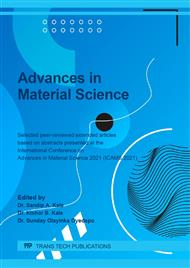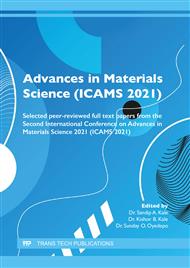[1]
S. Qian, Y. Dai, Y. Guo, Microstructure and Wear Resistance of Multi-Layer Ni-Based Alloy cladding coating on 316L SS under different laser power, Materials. 14 (2021) 781. https://doi.org/10.3390/ma14040781.
DOI: 10.3390/ma14040781
Google Scholar
[2]
J. Ning, D.E. Sievers, H. Garmestani, S.Y. Liang, G.W. Woodruff, M. Engineering, F. Drive, Analytical modeling of in-situ deformation of part and substrate in laser cladding additive manufacturing of Inconel 625, J. Manuf. Process. 49 (2020) 135–140. https://doi.org/10.1016/j.jmapro.2019.11.013.
DOI: 10.1016/j.jmapro.2019.11.013
Google Scholar
[3]
E. Toyserkani, A. Khajepour, S. Corbin, Laser Cladding Laser Cladding, (2017).
DOI: 10.1201/9781420039177
Google Scholar
[4]
M. Alizadeh-sh, S.P.H. Marashi, E. Ranjbarnodeh, R. Shoja-razavi, Laser cladding of Inconel 718 powder on a non-weldable substrate : Clad bead geometry-solidification cracking relationship, J. Manuf. Process. 56 (2020) 54–62. https://doi.org/10.1016/j.jmapro.2020.04.045.
DOI: 10.1016/j.jmapro.2020.04.045
Google Scholar
[5]
H. Materials, G. Wang, J. Zhang, R. Shu, S. Yang, International Journal of Refractory Metals High temperature wear resistance and thermal fatigue behavior of Stellite- 6 / WC coatings produced by laser cladding with Co-coated WC powder, Int. J. Refract. Metals Hard Mater. 81 (2019) 63–70. https://doi.org/10.1016/j.ijrmhm.2019.02.024.
DOI: 10.1016/j.ijrmhm.2019.02.024
Google Scholar
[6]
N. Thawari, C. Gullipalli, J. Kumar, T.V.K. Gupta, Effect of multi-layer laser cladding of Stellite 6 and Inconel 718 materials on clad geometry , microstructure evolution and mechanical properties, Mater. Today Commun. 28 (2021) 102604. https://doi.org/10.1016/j.mtcomm.2021.102604.
DOI: 10.1016/j.mtcomm.2021.102604
Google Scholar
[7]
Y. Huang, X. Zeng, Investigation on cracking behavior of Ni-based coating by laser-induction hybrid cladding, Appl. Surf. Sci. 256 (2010) 5985–5992. https://doi.org/10.1016/j.apsusc.2010.03.106.
DOI: 10.1016/j.apsusc.2010.03.106
Google Scholar
[8]
J. Leunda, C. Sanz, C. Soriano, Laser cladding strategies for producing WC reinforced NiCr coatings inside twin barrels, Surf. Coatings Technol. 307 (2016) 720–727. https://doi.org/10.1016/j.surfcoat.2016.10.002.
DOI: 10.1016/j.surfcoat.2016.10.002
Google Scholar
[9]
N. Thawari, C. Gullipalli, J.K. Katiyar, T.V.K. Gupta, Influence of buffer layer on surface and tribomechanical properties of laser cladded Stellite 6, Mater. Sci. Eng. B Solid-State Mater. Adv. Technol. 263 (2021) 114799. https://doi.org/10.1016/j.mseb.2020.114799.
DOI: 10.1016/j.mseb.2020.114799
Google Scholar
[10]
M. Manjaiah, J.Y. Hascoët, M. Rauch, Effect of process parameters on track geometry, microstructural evolution on 316L stainless steel multi-layer clads, Mater. Sci. Eng. B Solid-State Mater. Adv. Technol. 259 (2020) 114583. https://doi.org/10.1016/j.mseb.2020.114583.
DOI: 10.1016/j.mseb.2020.114583
Google Scholar
[11]
E.M. Stanciu, A. Pascu, M.H. Ţierean, I. Voiculescu, I.C. Roată, C. Croitoru, I. Hulka, Dual Coating Laser Cladding of NiCrBSi and Inconel 718, Mater. Manuf. Process. 31 (2016) 1556–1564. https://doi.org/10.1080/10426914.2015.1103866.
DOI: 10.1080/10426914.2015.1103866
Google Scholar
[12]
Kora T Sunny, Rosh V, Nikhil Dinesh, Rosh Luckose And Nevin Paul Zacharia, Implementation of Stainless Steel Buffer Layer for Reducing Crack Propagation on Regulating Valve Disc, Int. J. Eng. Res. V4 (2015) 414–417. https://doi.org/10.17577/ijertv4is040471.
DOI: 10.17577/ijertv4is040471
Google Scholar
[13]
A. Suárez, J.M. Amado, M.J. Tobar, A. Yáñez, E. Fraga, M.J. Peel, Study of residual stresses generated inside laser cladded plates using FEM and diffraction of synchrotron radiation, Surf. Coatings Technol. 204 (2010) 1983–1988. https://doi.org/10.1016/j.surfcoat.2009.11.037.
DOI: 10.1016/j.surfcoat.2009.11.037
Google Scholar
[14]
D.J. Corbin, A.R. Nassar, E.W. Reutzel, A.M. Beese, P. Michaleris, Effect of substrate thickness and preheating on the distortion of laser deposited ti-6al-4v, J. Manuf. Sci. Eng. Trans. ASME. 140 (2018) 1–9. https://doi.org/10.1115/1.4038890.
DOI: 10.1115/1.4038890
Google Scholar
[15]
E.R. Denlinger, J.C. Heigel, P. Michaleris, T.A. Palmer, Effect of inter-layer dwell time on distortion and residual stress in additive manufacturing of titanium and nickel alloys, J. Mater. Process. Technol. 215 (2015) 123–131. https://doi.org/10.1016/j.jmatprotec.2014.07.030.
DOI: 10.1016/j.jmatprotec.2014.07.030
Google Scholar
[16]
N. Thawari, C. Gullipalli, A. Chandak, T.V.K. Gupta, In fl uence of laser cladding parameters on distortion , thermal history and melt pool behaviour in multi-layer deposition of stellite 6 : In-situ measurement, J. Alloys Compd. 860 (2021) 157894. https://doi.org/10.1016/j.jallcom.2020.157894.
DOI: 10.1016/j.jallcom.2020.157894
Google Scholar
[17]
G. Muvvala, D.P. Karmakar, A.K. Nath, In-process detection of microstructural changes in laser cladding of in-situ Inconel 718 / TiC metal matrix composite coating, J. Alloys Compd. 740 (2018) 545–558. https://doi.org/10.1016/j.jallcom.2017.12.364.
DOI: 10.1016/j.jallcom.2017.12.364
Google Scholar
[18]
J.C. Heigel, P. Michaleris, T.A. Palmer, In situ monitoring and characterization of distortion during laser cladding of Inconel® 625, J. Mater. Process. Technol. 220 (2015) 135–145. https://doi.org/10.1016/j.jmatprotec.2014.12.029.
DOI: 10.1016/j.jmatprotec.2014.12.029
Google Scholar
[19]
A.J. Dunbar, E.R. Denlinger, J. Heigel, P. Michaleris, P. Guerrier, R. Martukanitz, T.W. Simpson, Development of experimental method for in situ distortion and temperature measurements during the laser powder bed fusion additive manufacturing process, Addit. Manuf. 12 (2016) 25–30. https://doi.org/10.1016/j.addma.2016.04.007.
DOI: 10.1016/j.addma.2016.04.007
Google Scholar
[20]
H. Liu, M. Li, X. Qin, S. Huang, F. Hong, Numerical simulation and experimental analysis of wide-beam laser cladding, Int. J. Adv. Manuf. Technol. 100 (2019) 237–249. https://doi.org/10.1007/s00170-018-2740-0.
DOI: 10.1007/s00170-018-2740-0
Google Scholar
[21]
Z. Yan, W. Liu, Z. Tang, X. Liu, N. Zhang, Z. Wang, H. Zhang, Effect of thermal characteristics on distortion in laser cladding of AISI 316L, J. Manuf. Process. 44 (2019) 309–318. https://doi.org/10.1016/j.jmapro.2019.06.011.
DOI: 10.1016/j.jmapro.2019.06.011
Google Scholar
[22]
G. Muvvala, D. Patra Karmakar, A.K. Nath, Online monitoring of thermo-cycles and its correlation with microstructure in laser cladding of nickel based super alloy, Opt. Lasers Eng. 88 (2017) 139–152. https://doi.org/10.1016/j.optlaseng.2016.08.005.
DOI: 10.1016/j.optlaseng.2016.08.005
Google Scholar



